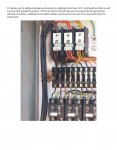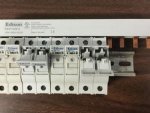GotShocked
Member
- Location
- Richland, WA, Benton County
We are experiencing repeated failures of Littelfuse CCMR 30A fuses within lighting control panels that serve 1000W Metal Halide lighting circuits. See attached photo. The fuses appear to be properly sized for short circuit current, in-rush & continuous loads. We can find not evidence of water intrusion or rodent getting across the fuses or other causes. Any ideas? We are considering temporary resonance as a possibility?



